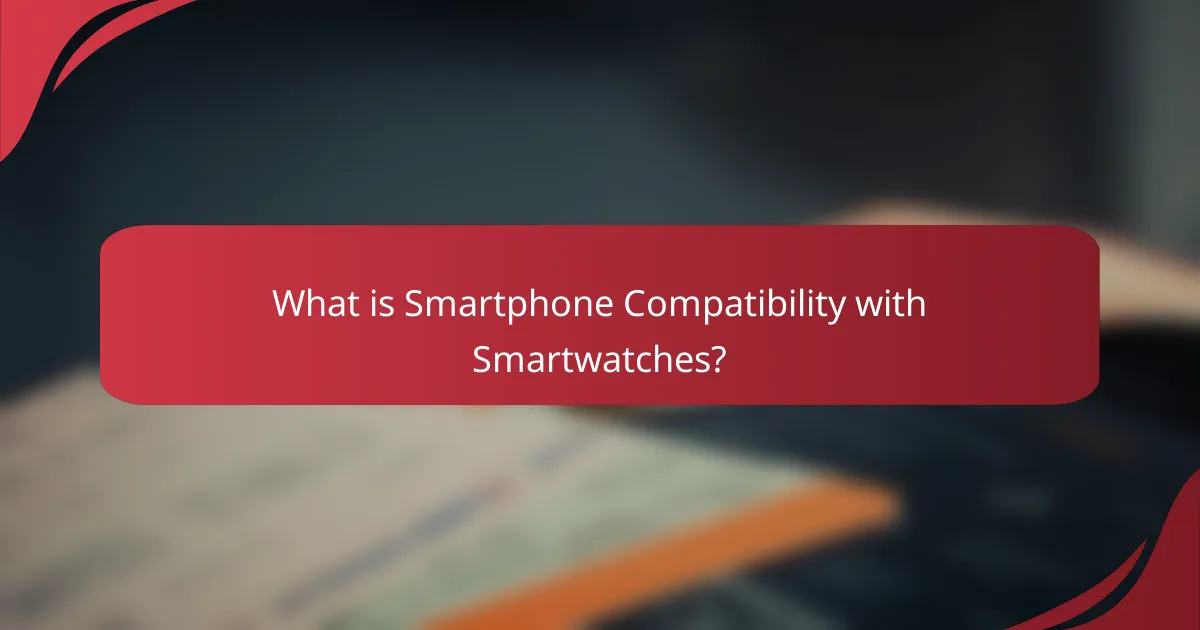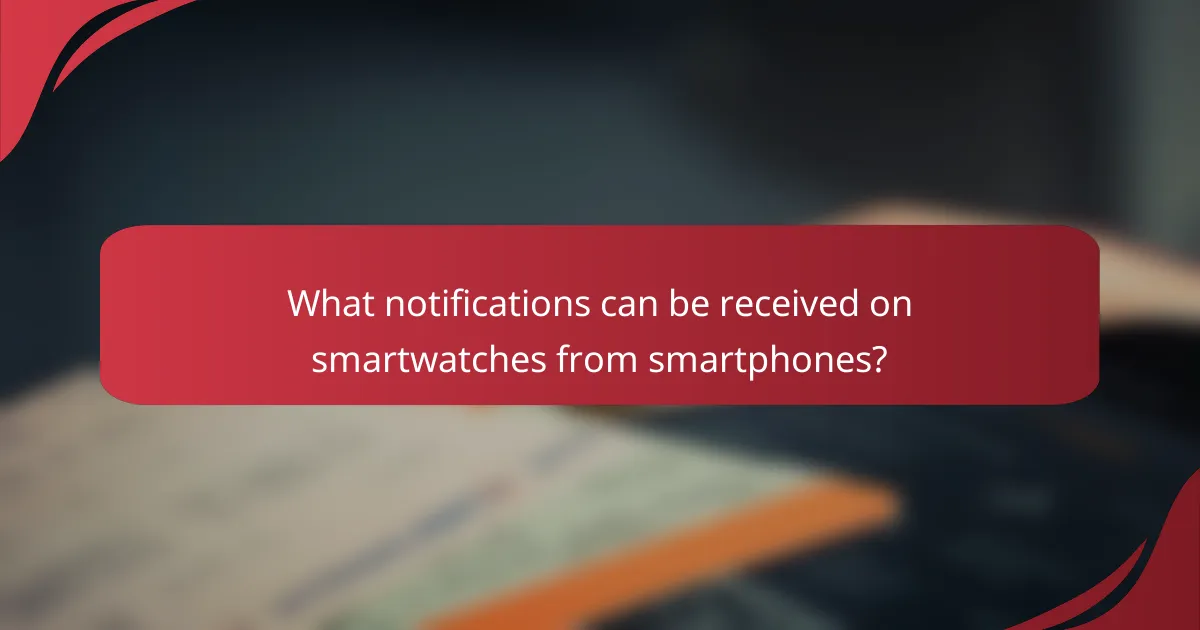Smartphone compatibility with smartwatches is the ability of smartwatches to connect and interact with smartphones, primarily through Bluetooth technology. This compatibility enables users to sync notifications, health data, and apps, enhancing the overall functionality of both devices. Smartwatches typically work with specific smartphone operating systems, such as iOS or Android, which can affect their performance and feature availability. Common notifications received on smartwatches include calls, messages, social media alerts, and fitness app reminders. However, challenges such as varying operating systems, Bluetooth connectivity issues, app compatibility, battery life concerns, and software updates can hinder seamless integration between smartphones and smartwatches.

What is Smartphone Compatibility with Smartwatches?
Smartphone compatibility with smartwatches refers to the ability of smartwatches to connect and interact with smartphones. This compatibility typically involves Bluetooth connectivity for syncing notifications, health data, and apps. Most smartwatches are designed to work with specific smartphone operating systems, such as iOS or Android. For example, Apple Watch is compatible only with iPhones, while many Android smartwatches can connect with various Android devices. Compatibility ensures that users can receive alerts, manage calls, and track fitness metrics seamlessly. Studies show that over 70% of smartwatch users rely on smartphone integration for enhanced functionality.
How do smartphones and smartwatches interact?
Smartphones and smartwatches interact primarily through Bluetooth connectivity. This connection allows for data exchange between the two devices. Notifications from the smartphone can be sent directly to the smartwatch. Users can receive alerts for calls, messages, and app notifications on their wrist. Additionally, smartwatches can sync health data, such as heart rate and steps, back to the smartphone. This syncing often occurs through companion apps specific to the smartwatch brand. For example, Apple Watch uses the Apple Health app for data integration. The interaction enhances user experience by providing quick access to information without needing to check the smartphone.
What technologies facilitate the connection between smartphones and smartwatches?
Bluetooth technology facilitates the connection between smartphones and smartwatches. Bluetooth allows for short-range wireless communication between devices. Most smartwatches connect to smartphones via Bluetooth to sync notifications and health data. Wi-Fi is another technology that enables connectivity when Bluetooth is not available. Some smartwatches also support cellular connectivity, allowing them to operate independently of smartphones. NFC technology is used for quick pairing between devices. These technologies ensure seamless integration and functionality between smartphones and smartwatches.
How does Bluetooth play a role in syncing devices?
Bluetooth enables wireless communication between devices, facilitating syncing. It allows smartphones and smartwatches to exchange data seamlessly. This connection supports notifications, health tracking, and app interactions. Bluetooth operates within a short range, typically up to 30 feet. Devices must pair to establish a secure connection. Once paired, they can share information like messages and fitness data. Bluetooth technology is standardized, ensuring compatibility across various brands. According to the Bluetooth Special Interest Group, over 4 billion Bluetooth devices are in use globally, showcasing its widespread adoption for syncing purposes.
What are the key syncing features of smartphones and smartwatches?
Key syncing features of smartphones and smartwatches include notifications, health tracking, and data synchronization. Notifications allow alerts from the smartphone to be displayed on the smartwatch. This feature enhances accessibility and ensures users do not miss important messages. Health tracking syncs fitness data between devices, enabling users to monitor their activity levels. This includes heart rate, steps, and sleep patterns. Data synchronization ensures that apps and settings are consistent across both devices. This allows for seamless user experience and real-time updates. The integration of these features improves user engagement with both devices.
What types of data can be synced between smartphones and smartwatches?
Smartphones and smartwatches can sync various types of data. Commonly synced data includes notifications, messages, and calls. Health data such as heart rate, steps, and sleep patterns are also shared. Calendar events and reminders can be synced between devices. Music playback controls and playlists are often accessible on smartwatches. Additionally, apps can exchange data for enhanced functionality. This syncing allows for seamless integration of features, enhancing user experience.
How do syncing features enhance user experience?
Syncing features enhance user experience by ensuring seamless integration between smartphones and smartwatches. This integration allows users to receive notifications instantly on their wrist. It eliminates the need to check their phone frequently. Users can track health metrics in real-time, promoting better health management. Syncing also enables the transfer of data, such as fitness goals and reminders, enhancing overall functionality. According to a study by the Journal of Medical Internet Research, users report higher satisfaction when devices are synchronized. This satisfaction stems from increased convenience and improved accessibility to information. Overall, syncing features create a more cohesive and efficient user experience.
Why is health tracking important in smartwatch and smartphone compatibility?
Health tracking is important in smartwatch and smartphone compatibility because it enhances user experience and provides valuable health insights. Smartwatches collect data on heart rate, activity levels, and sleep patterns. This information is synced with smartphones for comprehensive health monitoring. The integration allows users to access detailed analytics and trends over time. Compatibility ensures that notifications related to health metrics are timely and relevant. Research shows that users who track their health are more likely to engage in positive lifestyle changes. Improved compatibility also facilitates seamless updates and features related to health tracking. Overall, effective health tracking enhances the functionality of both devices, making them more beneficial for users.
What health metrics can smartwatches track when synced with smartphones?
Smartwatches can track various health metrics when synced with smartphones. Common metrics include heart rate, steps taken, and calories burned. They also monitor sleep patterns and quality. Many smartwatches can track blood oxygen levels and stress levels. Some devices offer ECG readings and skin temperature monitoring. These metrics provide users with insights into their health and fitness. The accuracy of these metrics is often validated through clinical studies and user feedback. Smartwatches utilize sensors and algorithms to gather and analyze this data effectively.
How does syncing improve the accuracy of health data?
Syncing improves the accuracy of health data by ensuring real-time updates between devices. This process allows for seamless integration of data collected from smartwatches and smartphones. Accurate data transfer reduces the likelihood of discrepancies in health metrics. For instance, heart rate readings are consistently updated, reflecting true physiological changes. Studies show that synced devices can decrease data entry errors by up to 30%. This accuracy is crucial for tracking trends over time, enabling better health insights. Additionally, syncing helps maintain a comprehensive view of health data, consolidating information from various sources.

What notifications can be received on smartwatches from smartphones?
Smartwatches can receive various notifications from smartphones. Common notifications include calls, messages, and emails. Social media alerts from platforms like Facebook and Twitter are also supported. Calendar reminders and event notifications can be synced as well. Fitness app alerts, such as step goals or workout reminders, are frequently received. Weather updates and news alerts can be pushed to the smartwatch. Additionally, app-specific notifications, like those from banking or shopping apps, can appear. The integration of these notifications enhances the user experience by providing real-time information on the wrist.
How do notification systems work between smartphones and smartwatches?
Notification systems between smartphones and smartwatches operate through Bluetooth connectivity. Smartphones send notifications to paired smartwatches using a dedicated app or operating system service. This communication allows alerts for calls, messages, and app notifications to be displayed on the smartwatch.
Smartwatches receive these notifications and can present them in various formats, such as vibrations, sounds, or visual alerts. Users can interact with notifications directly on their smartwatches. This feature enhances convenience by allowing quick responses without needing to reach for the smartphone.
The synchronization process involves establishing a connection via Bluetooth, which typically has a range of about 30 feet. Once connected, the smartphone continuously sends data packets to the smartwatch. This system ensures timely updates and maintains a seamless flow of information between devices.
What types of notifications can be customized on smartwatches?
Smartwatches allow customization of various types of notifications. Users can customize notifications for calls, texts, and emails. Additionally, social media alerts can be tailored to user preferences. Calendar reminders and event notifications are also customizable. Fitness tracking alerts, such as step goals or workout reminders, can be adjusted. Weather updates and news alerts can be personalized as well. Customization options enhance user experience by prioritizing important notifications.
How do users manage notifications from their smartphones on smartwatches?
Users manage notifications from their smartphones on smartwatches through specific settings and configurations. They typically enable notification mirroring in the smartwatch companion app on their smartphones. This allows incoming notifications to be displayed on the smartwatch screen. Users can customize which apps send notifications to the smartwatch. They can also set preferences for how notifications are displayed, including vibration and sound settings. Some smartwatches allow users to respond to notifications directly from the device. This functionality enhances convenience by reducing the need to check the smartphone frequently. Studies show that users appreciate this feature for its efficiency and ease of use.
What are the benefits of having synced notifications?
Synced notifications enhance user experience by consolidating alerts across devices. This ensures users receive messages, calls, and app notifications in real-time on their smartwatch. It reduces the need to constantly check their smartphone, promoting efficiency. Studies show that users with synced notifications report increased productivity and reduced distractions. Additionally, synced notifications facilitate timely responses to important communications, improving overall connectivity. Users can prioritize alerts, ensuring they focus on critical information first. This feature also helps in managing battery life, as checking notifications on a smartwatch consumes less power than a smartphone.
How do synced notifications enhance productivity?
Synced notifications enhance productivity by streamlining communication and task management. They allow users to receive alerts from their smartphones directly on their smartwatches. This feature minimizes the need to constantly check phones, reducing distractions. Studies indicate that focused work can improve productivity by up to 30%. By consolidating notifications, users can prioritize tasks efficiently. This capability enables quick responses to important messages without interrupting workflow. Additionally, synced notifications help in managing time effectively by reminding users of deadlines and appointments. Overall, they create a more organized approach to daily tasks, leading to increased efficiency.
What role do notifications play in user engagement with smart devices?
Notifications are crucial for enhancing user engagement with smart devices. They provide timely updates and alerts that keep users informed. This constant communication encourages users to interact with their devices regularly. Research shows that effective notifications can increase user retention by up to 50%. Notifications also facilitate quick responses to messages and alerts, making smart devices more functional. They can be personalized, tailoring the experience to individual preferences. This personalization increases user satisfaction and engagement. Overall, notifications serve as a bridge between users and their smart devices, driving frequent interaction and usage.

What are the challenges of smartphone compatibility with smartwatches?
Smartphone compatibility with smartwatches faces several challenges. One major challenge is the varying operating systems. Different smartphones run on platforms like iOS and Android, which may not support all smartwatch features. This limits functionality between devices. Another challenge is Bluetooth connectivity. Not all smartphones maintain stable Bluetooth connections, leading to frequent disconnections. Additionally, app availability can be an issue. Some smartwatches require specific apps that may not be compatible with all smartphones. Battery life is also a concern. Continuous syncing can drain smartphone batteries quickly. Lastly, software updates can create compatibility issues. If a smartphone or smartwatch is not updated, features may not work properly. These challenges hinder seamless integration between smartphones and smartwatches.
What common issues arise during the syncing process?
Common issues during the syncing process include connectivity problems, software compatibility, and data transfer errors. Connectivity problems often arise from weak Bluetooth signals or interference from other devices. Software compatibility issues can occur when the smartphone or smartwatch has outdated operating systems. Data transfer errors may happen due to insufficient storage space on the device or corrupted files. Additionally, user permissions may restrict access to necessary data, preventing successful syncing. These issues can lead to incomplete data synchronization or failure to connect altogether.
How can users troubleshoot syncing problems?
Users can troubleshoot syncing problems by checking Bluetooth connections. Ensure Bluetooth is enabled on both devices. Restart both the smartphone and smartwatch to refresh connections. Update the smartwatch and smartphone software to the latest versions. Remove and re-pair the devices if issues persist. Verify that the smartwatch app is correctly configured and permissions are granted. Check for any interference from other devices that may disrupt the connection. Finally, consult the user manual for specific troubleshooting steps related to the device model.
What factors can affect compatibility between smartphones and smartwatches?
Compatibility between smartphones and smartwatches can be affected by several factors. Operating system compatibility is crucial; both devices must support the same OS, such as Android or iOS. Bluetooth version also plays a role; newer versions offer improved connectivity and features. App availability is another factor; specific apps may be required for syncing data between devices. Hardware specifications can impact performance; more advanced smartphones may provide better integration. Battery life differences can affect functionality; a smartwatch may not perform optimally with a smartphone that has low battery. Finally, brand restrictions can limit compatibility; some smartwatches are designed to work only with their manufacturer’s smartphones.
What best practices can enhance smartphone and smartwatch compatibility?
To enhance smartphone and smartwatch compatibility, ensure both devices support the same operating system. This compatibility simplifies syncing and functionality. Use the latest software versions on both devices. Updates often include bug fixes and improved interoperability. Enable Bluetooth and Wi-Fi on both devices for seamless connectivity. This allows for faster data transfer and notifications. Utilize compatible apps designed for both smartphone and smartwatch. These apps can enhance functionality and user experience. Regularly check for app updates to maintain compatibility. This helps in addressing any issues that may arise. Lastly, consult manufacturer guidelines for specific compatibility recommendations. These guidelines provide valuable insights into optimal device pairing.
How can users optimize their device settings for better syncing?
Users can optimize their device settings for better syncing by adjusting specific configurations. First, ensure that Bluetooth is enabled on both devices. This allows for a stable connection between the smartphone and smartwatch. Second, check that both devices are updated to the latest software version. Updates often include improvements to syncing capabilities.
Next, configure app permissions to allow necessary data access. This enables the smartwatch to receive notifications and health data seamlessly. Additionally, users should adjust battery optimization settings. Disabling battery-saving modes for syncing apps can enhance performance.
Lastly, regularly restart both devices to refresh connections. This simple action can resolve many syncing issues. Studies show that maintaining these settings can significantly improve connection stability and data transfer efficiency.
What tips should users follow for effective health tracking and notifications?
Users should follow these tips for effective health tracking and notifications. First, ensure the smartwatch is compatible with the smartphone. This compatibility allows seamless syncing of health data. Second, regularly update both the smartwatch and smartphone apps. Updates often include improvements and new features. Third, customize notification settings to prioritize important alerts. This helps in managing distractions effectively. Fourth, use features like reminders for medication or exercise. These features promote adherence to health routines. Fifth, regularly review health data in the companion app. This practice helps users track progress and make informed decisions. Lastly, engage with community features if available. Community support can enhance motivation and accountability.
Smartphone compatibility with smartwatches refers to their ability to connect and interact, primarily through Bluetooth technology, enabling the syncing of notifications, health data, and applications. This article explores how smartphones and smartwatches interact, the technologies that facilitate their connection, and the key syncing features that enhance user experience. It also discusses the importance of health tracking in this compatibility, detailing the metrics that can be monitored and the role of notifications in user engagement. Additionally, the article addresses challenges in compatibility, common syncing issues, and best practices for optimizing device settings for effective health tracking and notifications.

